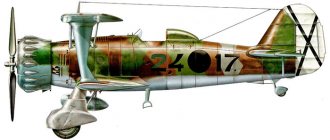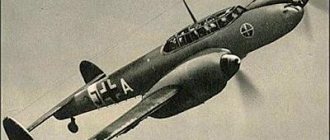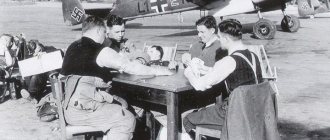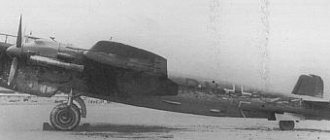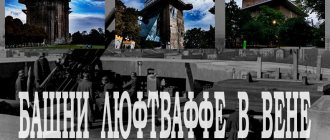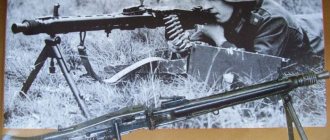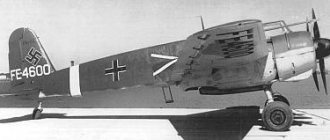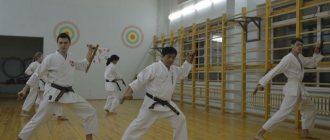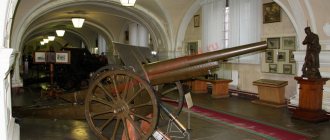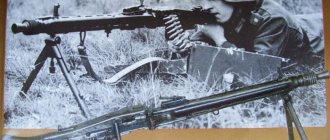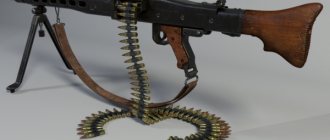Luftwaffe Henschel Hs-126 short-range reconnaissance aircraft
The problems that accompanied the development of the Heinkel He-46 forced the Reich Ministry of Aviation to urgently look for the possibility of creating an alternative “army aircraft” - in case the He 46 could not be brought to the required condition. Since the design bureaus of leading aircraft manufacturing firms were loaded with developments, a chance arose for a new one, where the newly created aviation design bureau was headed by F. Nikolaus.
Work on the project, designated Hs 122, began in 1933. Externally, the Hs 122 was very similar to the Heinkel Xe-46s, a two-seat strutted parasol monoplane with a fixed landing gear. But the technology of the planes was significantly different - the Henschel product was all-metal, and the fuselage was made as a monocoque. A total of 6 prototypes were built, flight tests of which began in May 1935. The aircraft with a Siemens SAM 22V engine (650 hp) showed good controllability and excellent takeoff and landing characteristics. But the maximum speed turned out to be only 10 km/h higher than that of the He 46, and otherwise the increase in flight data was considered too insignificant to introduce the Hs 122 into mass production. The company was recommended to continue improving the reconnaissance aircraft by installing a more powerful engine, and for in-depth testing, 7 pre-production Hs 122B-0 aircraft were ordered, delivered at the beginning of 1936.
One of the pre-production Hs 122B-0 became the first prototype of the modified Hs-126 reconnaissance aircraft with a new 9-cylinder air-cooled Bramo 323A-1 “Fafnir” engine (850 hp). The wing and landing gear underwent significant modifications, and the cabin became semi-enclosed. Three prototypes of the Hs-126 were produced, the first of which entered testing in August 1936.
The pre-production batch was delivered in the first half of 1938, and production of production vehicles began in June of the same year. Until January 1941, more than 600 Henschel Hs-126 biplanes were manufactured in Schönefeld and Johannishtal.
The history of the creation of the Hs.126 reconnaissance aircraft
In 1935, the specially built German reconnaissance aircraft He.122 made its first flight. However, just before the completion of work on the aircraft, we had to face the most hated problem for any contractor - the customer suddenly changed the requirements for the future aircraft.
The He.122 did not meet the new requirements, so it was decided to hastily create a modified version with a more powerful engine, better performance and a slightly modified design. The name of the new aerial reconnaissance aircraft for the Luftwaffe was changed to He.126 , and the 4th prototype of the unsuccessful He.122 was converted into a “new product”.
The project to create the He.126 aircraft was led by permanent engineer F. Nikolaus.
Drawing of the Henschel Hs.126 aircraft
Given the circumstances, the first He.126 prototype took to the skies in the fall of 1936. Since its characteristics have only improved compared to its predecessor, the tests did not take too long. Serial production of the aircraft began in 1937, and in the spring of 1938 it began to enter service with the troops.
Production of the Hs.126 was organized in Schönefeld and Johannishtal and continued until January 1941. During this time, a total of 510 aircraft of this type were manufactured.
In addition to Germany, the Hs.126 was in service with Greece and Estonia. The latter were included in the Red Army Air Force of the USSR in 1940.
Henschel 126 is certainly not handsome
Links[edit]
| Wikimedia Commons has media related to Henschel Hs 126 . |
Notes[edit]
- Simkin, John. "Henschel Hs 126B". Archived December 3, 2012, on the Wayback Machine Spartacus Educational.
Access date: September 12, 2012. - Raid: Saving Mussolini, Robert Forczyk - Osprey Publishing, April 2010; 64 pages; ISBN 9781846034626
- Jump up
↑ Carr 2012, p. 4-17
Design of the Hs.126 reconnaissance aircraft
The Hs.126 reconnaissance aircraft is built according to the aerodynamic design of a braced high-wing aircraft, with an oval-section fuselage with working skin.
The wing is two-spar with V-shaped struts. The landing gear is fixed, tricycle, with a tail wheel.
The power plant of the Hs.126 consisted of a piston 9-cylinder air-cooled star engine with a three-blade variable pitch propeller.
The cockpit in the front part is closed with a sliding canopy. Under the observer's seat there was a compartment with a Zeiss-Rb automatic camera. A hand-held camera was attached to the left side of the ship.
Reconnaissance aircraft "Henschel-126"
Combat use
The first combat use of the aircraft took place in the fall of 1938 in Spain, and by the beginning of World War II, the Hs-126 was the main short-range reconnaissance aircraft of the Luftwaffe. The aircraft also participated in all major Wehrmacht campaigns until November 1941, after which it began to reorient itself to the role of a night reconnaissance aircraft. It was used in this role until the end of the war. From mid-1942, it was also used as a night light bomber and in rear units. The Luftwaffe was not officially withdrawn from service.
Armor protection, maneuverability and defensive weapons made it difficult to fight the scout:
The Henschel-126 spotter aircraft, which the infantrymen nicknamed the “crutch,” had good maneuverability, had armor protection, and was equipped with defensive weapons. When fighters appeared, he quickly went under the protection of anti-aircraft weapons. In addition, the spotter’s actions were often covered by Messerschmitts. It was not easy to shoot down this plane.
— S. N. Ikonnikov “War through the eyes of an aircraft engineer”
Modifications of the Hs.126 reconnaissance aircraft
- Hs.126V1 - the first prototype with a Jumo.210C liquid-cooled engine with a three-bladed propeller and no cockpit canopy. Converted in autumn 1936 from Hs.122B-0.
- Hs.126V2 - the second prototype with the Bramo-323A-1 engine with 830 hp. with a turbocharger and a three-blade VDM propeller, an enlarged keel. Manufactured in early 1937.
- Hs.126V3 - the third prototype with an enlarged keel and landing gear. Manufactured in early 1937.
- Hs.126a - pre-production, with Bramo "Fafnir-323A" engine with 850 hp. In 1937, 10 aircraft were manufactured.
- Hs.126A-1 is a serial reconnaissance aircraft with a BMW-132Dc engine with direct fuel injection.
- Hs.126B-1 - with Bramo engine “Fafnir-323A-1” (A-2, Q-1, Q-2). It was distinguished by the presence of a FuG-17 radio station.
Literature[ | ]
- Bykov Mikhail.
Combat “Crutch” by Friedrich Nikolaus, part 1 (Russian) // Arsenal-Collection: magazine. - M., 2013. - Issue. 5 (11). - P. 18-23. - Bykov Mikhail.
Combat “Crutch” by Friedrich Nikolaus, part 2 (Russian) // Arsenal-Collection: magazine. - M., 2013. - Issue. 6 (12). - P. 18-23. - Kotelnikov Vladimir.
“Crutches” fly on reconnaissance (Russian) // Wings of the Motherland: magazine. - M., 1995. - Issue. 7 (774). — P. 22-25. — ISSN 0130-2701. - Mariinsky E.P.: I fought in an Airacobra. - M.: Yauza, Eksmo, 2005
- Horst Materna: Die Geschichte der Henschel Flugzeugwerke in Schönefeld bei Berlin 1933–1945., 4. Auflage, Rockstuhl, Bad Langensalz 2016, ISBN 978-3-86777-049-1.
- Klaus Wartmann: Henschel-Flugzeuge 1933–1945. Rockstuhl, Bad Langensalza 2011, ISBN 978-3-86777-407-9.
- Green, William. Warplanes of the Third Reich. London: Macdonald and Jane's Publishers Ltd., 1970 (fourth impression 1979). ISBN 0-356-02382-6.
- Luranc, Zbigniew. Henschel Hs 126 - Skrzydła w Miniaturze (in Polish). Gdańsk, Poland: Wydawnictwo Avia-Press, 1995. ISBN 83-902964-0-3.
- Nowarra, Heinz J. Nahaufklärer, 1910-1945: Die Augen des Heeres (in German). Stuttgart, Germany: Motorbuch Verlag, 1981. ISBN 3-87943-808-0.
- Pęczkowski, Robert and Panek, Robert. Henschel Hs 126. Sandomierz, Poland/Redbourn, UK: Mushroom Model Publications, 2008. ISBN 83-89450-40-1.
- Smith, J.Richard and Kay, Anthony. German Aircraft of the Second World War. London: Putnam & Company Ltd., 1972 (third impression 1978). ISBN 0-370-00024-2.
- Wood, Tony and Gunston, Bill. Hitler's Luftwaffe: A pictorial history and technical encyclopedia of Hitler's air power in World War II. London: Salamander Books Ltd., 1977. ISBN 0-86101-005-1.
Characteristics of Henschel Hs.126
A country:GermanyType:Reconnaissance aircraftYear of issue:1936Crew:2 peopleEngine:1x BMW.132Dc 880 hpMaximum speed:354 km/h, cruising 270 km/hPractical ceiling:8200 mRange of flight:715 kmEmpty weight:2032 kgMaximum take-off weight:3275 kgWingspan:14.50 mLength:10.85 mHeight:3.75 mWing area:31.6 sq.m.Weapons:1x 7.92 mm MG-17 machine gun (synchronous with propeller, 500 rounds), 1x 7.92 mm MG-15 machine gun (on the turret in the rear of the cabin, 975 rounds). Up to 150 kg bomb load (in the photo compartment: 10x10 kg + under the fuselage: 1x 50 kg)
Characteristics are given for model Hs.126A-1
See also[edit]
Aircraft of comparable role, configuration and era
Related Lists
- List of World War II aircraft
- List of German military aircraft of World War II
- List of German military aircraft
Links[ | ]
- Corner of the sky (Russian)
- fliegerweb (German)
- historyofwar (English)
| Luftwaffe reconnaissance aircraft | ||
| ||
| Aircraft and rockets produced by Henschel | |
| |
Cloudy skies 1941
Commander of the 9th GvIAD A.I. Pokryshkin (far right) and a group of pilots of the 16th GvIAP. Third from the right - G. A. Rechkalov For those who were interested in the history of the 55th IAP, subsequently the 16th GvIAP, as well as the combat work of the 9th GvIAD (from July 2, 1944, commander A. I. Pokryshkin) and its personnel , the strained relationship between the division commander and the second most successful ace of the Soviet Air Force (on his account: 61 + 4, previously considered: 56 + 6, downed enemy aircraft), Twice Hero of the Soviet Union Grigory Andreevich Rechkalov, is obvious. Some time ago, the aviation community even debated on the pages of online forums, trying to understand the nature of the relationship between the two pilots, believing that the reasons lay in their rivalry in the air. At the same time, various aspects of their combat interaction were considered.
One way or another, it began to seem that the strained relations between the aces, which then resulted in a serious conflict, were caused by their personal battle scores. Recently, this has been confirmed by the words of G. A. Rechkalov’s relatives, in particular, his wife Anfisa Yakovlevna Rechkalova and their daughter, Lyubov.
| G. A. Rechkalov. |
According to the latter, in reality, the conflict between Rechkalov and Pokryshkin was that after the war, Rechkalov, working with TsAMO documents, discovered 3 of his planes shot down in 1941 on his account.
.. Pokryshkina. Having learned about this, Rechkalov called Pokryshkin and told him about his find and, in all likelihood, what he was thinking about his comrade and boss. Pokryshkin’s reaction was such that after this conversation they forgot about Rechkalov, and he himself was denied admission to TsAMO. Even Georgy Golubev, Pokryshkin’s wingman, with whom Rechkalov was friends during the war, and with whom, already as a student at the academy in Monino, hiding behind the columns of the church, secretly baptized his daughter, in the book “Paired with the Hundredth” for some reason he hardly talks about to his friend, building his narrative entirely around Pokryshkin’s personality. Now about the post-war activities of Twice Hero of the Soviet Union, Major General (1957) Grigory Andreevich Rechkalov, you can only find meager phrases without indicating the places of his service. According to relatives, Rechkalov adhered to his opinion regarding the “seizure” of 3 aircraft from his personal account until his death in 1990.
Taking into account a number of circumstances, which will be discussed in more detail below, the conflict could have been caused by planes shot down (or not shot down) by one of these pilots in the summer of 1941. Let's first consider how both pilots performed in the first months of the Great Patriotic War. Let's start with Rechkalov - his combat account, confirmed by archival documents, from 06/22/1941 opens with the following downed vehicles:
| 1) June 26, 1941 | 1 Me-109 | Ungheni | |||
| 2) June 27, 1941 | 1 Khsh-126 | eastern Boksha | |||
| 3) 07/11/1941 | 1 Yu-88 | Balta |
However, just a month after the start of the war, Rechkalov was seriously wounded in his right leg. This happened on July 26, 1941, during a combat mission between 12:55 and 13:40. As part of the I-16 flight, Lieutenant G. Rechkalov accompanied 7 I-153 from the 299th ShAP on the attack. In the Dubossary area, when approaching the target, a group of aircraft came under enemy anti-aircraft artillery fire. Rechkalov was wounded, and the hit was strong and accurate - the rudder pedal of his plane was broken in half. The pilot himself described this episode after the war as follows:
“I looked into the cabin and didn’t believe it... Half of the broken right pedal was lying on the floor in an oily brown puddle. The toe of the boot, half torn apart, was a mess of pieces of leather and blood. I tried to move my leg, but it didn’t obey. Only now the meaning of what happened reached my consciousness and shook me with a cold chill.”
Rechkalov tried to head for his airfield, but his Donkey was spotted by several Bf-109s, which decided to finish him off. One way or another, the pilot managed to escape from them and land at his airfield. After landing, he was immediately sent to the hospital.
Grigory managed to return back to the regiment (which by that time had already received the Guards rank and became the 16th GvIAP) only in April 1942. Having arrived, and illegally, since the leave granted by the hospital authorities for a trip home to the Urals was already overdue, he learned that the 3 planes he shot down in the summer of 1941 would not be credited to him, since the documents of the 55th IAP were burned during the retreat in the summer of 1941. As the pilot himself later wrote in his book “The Smoky Sky of War,” at the regiment headquarters he was literally told the following: “We’ll have to start fighting all over again. During the retreat, during the encirclement, all documents, including your flight book, had to be burned.” We believe that then Rechkalov was not particularly upset by this news - for him, probably, the main thing was that he escaped from the hospital, and this escape remained for him without unpleasant consequences, although regiment commander V.P. Ivanov announced 5 days of arrest for him.
It should be noted here that part of the documents of the 55th regiment, containing information about the results of the combat activities of the unit’s pilots in the initial period of the war, was indeed destroyed. However, the planes shot down by Rechkalov before the hospital are reflected in other documents - “Operational reports” and “Log of records of downed enemy aircraft” of the 20th SAD, which at that time had already been disbanded. True, by the time the pilot returned to the regiment, these documents were no longer available. It’s not clear where anyone would send requests to officially confirm and include these victories in Rechkalov’s new flight record book in 1942.
One way or another, from that time on, the official countdown of Rechkalov’s victories after his arrival in the 16th GvIAP in the spring of 1942 began with the one Me-110 he shot down on May 25, 1942. As a result, in the first submission for the title of Hero of the Soviet Union by May 1, 1943, Rechkalov got: 12 personally and 2 in the group, that is, 14 in total. Calculating Rechkalov’s victories according to archival documents gives a result of 17 victories for the same period. Thus, it is clear that the first 3 victories of the summer of 1941 were not taken into account.
Perhaps the “account reset” occurred due to the fact that Rechkalov was not in the unit for almost a year due to injury. During this time, the regiment transferred to another formation, and information about Rechkalov’s victories remained in the documents of the 20th SAD. There was no data left in the regiment. The report on the combat work of the 16th GvIAP was already compiled in the reserve air regiment. Therefore, there was nowhere to get data for 1941.
However, given that Rechkalov himself was subsequently convinced that 3 downed planes were “removed” from his account, another reason seems more likely, and the fact that Rechkalov was absent for about a year played a certain role in the “disappearance” of victories.
The point is that for many pilots of the 55th IAP, despite the burned documents, the downed planes were recorded again, and only one “returnee” Rechkalov in the regiment had to start his combat account from “zero”.
| A. I. Pokryshkin. |
Biographer A. I. Pokryshkin O. Levchenko in one of his works cites the following fact:
“Apparently, the number of combat sorties for the pilots of the 55th IAP after the loss of documents was restored and entered into new flight books from memory (or through rough mathematical calculations). In the memoirs of G. Rechkalov there is a mention of the clerk of Kravchenko’s headquarters, who had an excellent memory, but for the official recording of an aerial victory, documentary evidence was required, and they died. In addition, the number of combat sorties at that time did not give fighter pilots any special differences, so it was possible to restore them, as they say, “by eye.”
Please note - it turns out that it was still possible to confirm the downed planes. Moreover, there is a contradiction. It turns out that for someone in the regiment, victories were still credited retroactively from memory, or “through rough mathematical calculations” (not to mention the documents of the headquarters of the 20th SAD, the very fact of whose existence is apologists for the “complete disappearance” of the regiment’s victories over the summer 1941, starting with A.I. Pokryshkin himself and ending with O. Levchenko, is unanimously ignored). Therefore, it is strange that Rechkalov’s 3 victories were not credited. Moreover, many in the squadrons often remembered the planes of others shot down in the first difficult months of the war. One way or another, Rechkalov did not have the first 3 victories, while all the pilots who remained in service in the fall of 1941 had this problem solved.
Meanwhile, it is noteworthy that, according to the operational reports of the 20th SAD, confirming the victories of Grigory Rechkalov, another pilot of the 55th IAP, namely Alexander Pokryshkin, has no records of planes shot down at the beginning of the war.
At the same time, Pokryshkin himself, in his widely known memoirs and diary entries, repeatedly wrote about many of the planes he shot down in the summer of 1941. At the same time, he always drew the attention of readers to the problem with confirming these victories, caused by the lack of regimental documents. However, according to the “Report on combat work and combat training of the 16th GvIAP”, compiled at the beginning of 1943, when the regiment arrived at the 25th ZAP for retraining on new equipment, Pokryshkin himself never lost planes from his account. At the same time, it is interesting that in Pokryshkin’s memoirs and notes, the planes he allegedly shot down in the summer of 1941 differ in type. Levchenko, who believes that Pokryshkin’s official battle score is greatly underestimated, justifies this fact for a number of reasons. He also gives a list of the first victories, taken from the notes of Pokryshkin himself. It turns out that the first planes shot down by Senior Lieutenant A.I. Pokryshkin were:
| 1) | 1 Bf 109 | ||
| 2) | 1 Bf 109 | ||
| 3) | 1 Ju 88 | ||
| 4 — 5) | 2 Hs 126 - in one flight |
There are interesting notes from Levchenko about the downed ones, recorded by Pokryshkin himself, and I will give them in full:
"2. According to the notes in A.I. Pokryshkin’s notes, this “Junkers” was credited to him as a general (that is, group) victory.
3. The downed Ju-88 was not credited to Pokryshkin. Alexander Ivanovich shot down the “eighty-eighth” with an RS (missile) and damaged another one at the moment when they took a combat course, trying to bomb a floating dock towed by a patrol ship, guarded by a sea hunter. “Regimental headquarters sent a request to confirm the downing of the Junkers.” Suddenly the refusal came. The sailors motivated him by the fact that they, too, were firing intensely from boats at a group of bombers. In addition, we picked up paratroopers on the water.” [12, p. 118]
4. The downed Hs-126 was not credited to Pokryshkin. Alexander Ivanovich did not have time to report on the aerial victory, as he was accused of alarmism. The fact is that “Henschel” was shot down during a reconnaissance flight to the mountain area. Nikolaev, where Pokryshkin discovered columns of German tanks and vehicles moving towards the city, which he reported.”
Pay attention to the following, 5th point:
"5. On August 13, fascist tank units reached the sea east of Odessa near the village of Koblevo, surrounding the city. At this time, a group of employees and guards from the headquarters of the 55th IAP, which had left Berezovka for Tuzly, where the regiment had flown, ran into the Germans who had broken through. In the current situation, it was necessary to burn the headquarters bus and secret documents, “including the results of military operations since the beginning of the war. All the data on the planes we shot down and confirmations on them... The senior staff group was severely punished, but this did not resurrect the results of our two-month military operations.” [12, p. 126] Consequently, it is not possible to use archival data to confirm most of A.I. Pokryshkin’s aerial victories for 1941.”
Noteworthy is the last phrase that most of the planes shot down by Pokryshkin cannot be identified through archival means. In addition, it was already mentioned above that in the operational reports of the 20th SAD there are no downed planes recorded for Pokryshkin at all, while there are aerial victories of Rechkalov, Figichev, Shelyakin and other pilots of the 55th IAP.
It is puzzling why all this fuss with lost documents, the difference between Pokryshkin’s memoirs and notes, an incomprehensible account, into which some supposedly “not counted” victories are still wedged in. Levchenko’s behavior in this case resembles the work of a lawyer, he uses every opportunity to remind of the “objective” reasons why Pokryshkin has inaccuracies with personal victories and immediately refers to Pokryshkin’s “well-known honesty and severity” towards himself , they say, such a person simply could not write a lie about his personal achievements! What is this for? Why does the author endlessly remind us of the large number of planes shot down by Pokryshkin in the summer of 1941, adding that although there are “some” problems with their confirmation (most of them are not confirmed at all), nevertheless, his count is not correct doubt ?
According to Pokryshkin’s account recently established by M. Bykov from documents stored in TsAMO, it follows that the planes shot down by this pilot in 1941 were:
| 1) June 26, 1941 | 1 Me-109 | The battle area is not indicated in the documents | |||
| 2) 07/03/1941 | 1 PZL-24 | Straseni district | |||
| 3) 07/05/1941 | 1 Khsh-126 | paired with regiment commander Ivanov |
Defending the veracity of Pokryshkin, citing naive arguments presented as “obvious and indisputable” as confirmation of the ace’s personal account at the initial stage of the war, relying on a source base almost entirely based on the memoirs and notes of Pokryshkin himself and some of his subordinates, Levchenko at the same time time writes the following about Rechkalov:
"G. A. Rechkalov is subjective in his memories ( the relationship between him and Pokryshkin was strained ). For example, when describing the events of the first month of the war (G. A. Rechkalov was seriously wounded on July 26, 1941, he returned to the regiment only in April 1942), he mentions A. I. Pokryshkin only twice.”
This characterization is surprising: why can’t Rechkalov’s memories be trusted, where does such confidence in their “subjectivity” come from? After all, he was exactly the same fellow soldier of Pokryshkin as the rest of the pilots, whose statements Levchenko so easily takes on faith and even uses as sources? On what, in this case, is Rechkalov’s “exclusive” subjectivity based?
The characterization given by Levchenko to Rechkalov’s book “The Smoky Sky of War” has already been given above. Let us add that in his other book, “In the Skies of Moldova,” describing the initial period of the war, Rechkalov does not write about Pokryshkin at all, there is “not a single mention of his name ,” as if Senior Lieutenant “Sasha Pokryshkin” was in the 55th IAP there wasn't at that time. In addition, many of the facts described by Pokryshkin in his memoirs are described by Rechkalov in a completely different way, and what is most striking is that Pokryshkin is not a participant at all. But this seemingly completely “subjective” approach actually has very objective and fairly simple reasons: Rechkalov and Pokryshkin flew on different types of aircraft, in different groups and almost never crossed paths during combat missions. Moreover, Rechkalov, unlike his comrades in arms, accompanies his memoirs with excerpts from documents of the 20th SAD. It is characteristic that these inconsistencies concern all moments and events of the first month of the war, which Pokryshkin identifies as key and the central figure of which, according to him, is himself. It is probably for these reasons that Rechkalov’s memories are so easily dismissed by Levchenko as “subjective”, but in fact “inconvenient” for Pokryshkin’s apologetics.
In addition, it is of interest that, according to all of Pokryshkin’s memoirs, the only witnesses to the first planes he shot down were the dead pilots - Semyonov, Dyachenko, Dovbnya. It turns out that by the end of 1941 these witnesses could not confirm what exactly Pokryshkin shot down and whether he shot down at all. Strange, isn't it? And the types of the first planes he shot down, judging by his description, are the same as those that Junior Lieutenant G. Rechkalov managed to shoot down before he was wounded.
Here it must be said that the issue of the planes shot down by Pokryshkin in 1941 has already been raised earlier. In particular, in the book “Soviet Aces” - a translation of the Polish edition of P. Skulsky, I. Bargiel, G. Cisek “Aces of the Eastern Front”, Pokryshkin’s own words about the loss of more than 10 downed enemy aircraft due to the loss of regimental documents are called into question in August 1941.
So, what do we have at our disposal? First. We have Rechkalov, who escaped from the hospital in the spring of 1942, and who unexpectedly “arrived” at his regiment in April. Surely no one was waiting for him there. Upon arrival, he learns that the first 3 planes he shot down will not be credited to him.
Second. Shortly before Rechkalov returned, on March 14, 1942, the regiment commander of the 16th GvIAP V.P. Ivanov signed the first nomination for the title of Hero of the Soviet Union in the name of Pokryshkin. It states that A. Pokryshkin:
“During the hostilities, he had 288 combat sorties, of which: to attack enemy troops - 63; for reconnaissance of enemy troops - 133; to escort their bombers - 19; to cover their troops - 29; to intercept enemy aircraft - 36; for reconnaissance with attack - 8. Participated in 26 air battles, personally shot down 4 enemy aircraft and 3 aircraft as part of a flight , destroyed and disabled 45 enemy vehicles, more than 200 soldiers and officers. In unequal air battles he was shot down twice.”
However, then the performance was “wrapped up”, it was shelved, and it was not allowed to proceed. One gets the impression that this circumstance could be directly related to the return of Rechkalov to the regiment, which by that time everyone had already forgotten. A.I. Pokryshkin did not become a Hero of the Soviet Union then. Nevertheless, the enemy aircraft shot down in 1941 firmly “settled” on his account, and his nomination for the title of GSS confirmed this.
Here it must be said that by that time the most effective pilots in the regiment had already been clearly identified - the leaders. In the operational reports of the 20th SAD, the names of Figichev are often found, who shot down 9 aircraft in the first month of the war (in total in the first year of the war - 11), Ivachev (before his death on October 14, 1941 - 7 personal victories), Rechkalov, Shelyakin (before that , how he was captured on July 13, 1941 - 4 personal victories), Dyachenko (before his death on July 31, 1941 - 4 personal victories), Seliverstova.
| K. E. Seliverstov. |
By the way, with the name of the first Hero of the Soviet Union in the regiment, Kuzma Egorovich Seliverstov, there are also some doubts associated with the veracity of the memoirs of Pokryshkin, who wrote the following verbatim:
“Kuzma didn’t shoot down many enemy planes, but how many of us did he save the lives of in air battles! A modest, shy person, a direct and honest comrade, a true fighting friend.”
However, it turned out that at the time of his death on October 15, 1941, K. E. Seliverstov’s combat score was, according to various documents, from 8 + 2 to 10 + 2 (personally + in the group) downed aircraft - the best result in the 55th regiment!
It is at least strange that Pokryshkin writes about the most effective pilot of the regiment at the time described in such a condescending tone... By the way, in fairness it must be said that Pokryshkin’s name also appears in the reports of the 20th SAD, describing the events of the summer of 1941, but in connection with other circumstances:
“07/15/1941. 6.30-9.40, 2 reconnaissance flights were made to the Orhei region... Did not return Art. Lieutenant Pokryshkin on the MiG-3. On the second flight, the crews discovered 3 km north. A broken MiG-3 in a swamp in Grozesti. Presumably Art. Lt. Pokryshkina.
On July 18, 1941, Lieutenant Pokryshkin returned from an emergency landing.
07/28/1941 At 6.25 two MiG-3s carried out reconnaissance in the area of river crossings. Dniester in the Stroynitsy district, Grigoriopol. Art. Lt. Pokryshkin, returning from reconnaissance due to weather conditions, landed at the Semyonovka airfield.”
An interesting fact - according to the “Report of the 16th GvIAP on combat work and UBP for 1943,” Pokryshkin had air victories by the time the regiment was withdrawn from the front to the 25th ZAP for retraining on a new type of fighter P-39 “Airacobra” as air victories are listed as “3 + 4”, which are the sum of the results of his combat activities for 1941-1942:
| 1941 — 2 + 1 | |
| 1942 — 1 + 3 |
Thus, it turns out that from the beginning of the war - from June 22, 1941 to December of the same year, Pokryshkin officially shot down 2 planes personally and 1 in the group. At the same time, it is very characteristic that in the same report Rechkalov has no victories for 1941 at all . A natural question arises: why does the future Three-Time Hero have so few victories - only 3? But where are the rest of the planes that Pokryshkin wrote down in his memoirs and which were supposed to be read to him from memory or “through mathematical calculations”?..
This is how in his notes “We are not fighting for the sake of counting” Pokryshkin writes about the first plane he shot down. By the way, a witness to this battle was the pilot Semyonov, who thought that Pokryshkin’s burning MiG was falling, and a few days later he died:
"1. Fight in the Ungheni area with 5 Me-109. On one of the first days, when flying out to reconnoiter the crossings in the Ungheni-Stephanesti area on the river. Prut and his wingman Semenov, we met 5 Me-109s covering the crossing in the Ungheni area. Below was a trio of Me-109s, above - a pair. I was about to rush at them, but then, remembering that I was forbidden to get involved in the battle, but was ordered to give intelligence data, I turned north along the Prut. The Messera discovered us and approached us from the left rear. To avoid being shot down, we turned on them and attacked 3 Me-109s head-on. After jumping over, I made a vertical slide with a shift to the right wing, which allowed me to get out from above the back of the 3 Me-109. I attacked them. But at that time I saw the tracks going to my right, the top pair attacked me. Again I made a vertical slide with the transfer on my back at the top. A pair of Me-109s appeared below and in front of me, I went to attack them, but at that time I saw Semenov’s plane below. He was in a rollover, and there was a puff of white smoke behind his plane. The Mö-109 was attached to it behind. To save my wingman, whom I already considered shot down, judging by the white puffs of smoke, I dived onto the Me-109 attacking him and found myself lower behind him.
After my first burst, the Me-109 took off somewhat, and after the second it caught fire. Then I stared at the burning Me-109 and forgot about the enemy. This was the first burning plane I saw. While I was watching him, I heard bullets hitting and shells exploding in my plane. My plane flipped onto its back. The shell knocked out the star on the right wing and smashed the center section. I turned the plane around and continued the fight, but it was difficult to fight. When moving to high speed, the plane tended to roll over. Figuring that Semyonov had already gone far, I decided to leave the battle. The Me-109s, after losing their Me-109s, did not fight particularly actively, and I freely dived out of the battle.
Semyonov had no injuries, but made a mistake: he gave afterburner and did not lighten the propeller, which is why his engine malfunctioned, and he left the battle.
In this battle, I shot down an Me-109, which fell in the Ungheni-Pyrlitsa area.”
Please note that the area where the Me-109 was shot down, as well as the date, completely coincide with the crash site of the first plane shot down by Rechkalov - Ungheni. The type is the same. Interesting coincidence, isn't it? It is here that Levchenko’s arguments become quite understandable, “convincingly” proving why Pokryshkin’s destroyed planes are “not hit” in various sources.
| N.V. Isaev. |
Soon after the events of the spring of 1942 described above, an accident occurred with regiment commander V. Ivanov (his arm was broken by an airplane propeller), and Nikolai Vasilyevich Isaev (future General - Major of Aviation) became the commander of the 16th GvIAP. This is where Ivanov’s trusting leadership and support ends for Pokryshkin and his memoir confrontation with Isaev begins, which, in the opinion of the pilot himself, resulted in his persecution. Actually, what the conflict between them was is also unclear. According to Pokryshkin, Isaev’s incompetence as a commander and pilot. However, we do not know Isaev’s position, and in his post-war memoirs, oddly enough, he praises Pokryshkin.
Until now, we can judge the essence of the conflict only from descriptions of one side - Pokryshkin. We can only add that Colonel N.V. Isaev, who was appointed with a significant promotion in June 1944 as the commander of a completely reformed Until now, we can only judge the essence of the conflict from the descriptions of one side - Pokryshkin.
We can only add that Colonel Nikolai Vasilyevich Isaev, appointed with a significant promotion in June 1944, commander of the completely reformed (the entire regimental composition of the formation was replaced) 273rd Fighter Air Division, like the “Pokryshkin” 9th GvIAD, entirely armed with “Airacobras” ", he commanded it very successfully, and until the end of the war, unlike A.I. Pokryshkin, he himself repeatedly flew on combat missions leading groups of fighters, mainly to attack ground targets, and on April 6, 1945, for 272 combat sorties (by February 1945), 38 air battles and the shooting down of 9 enemy aircraft personally and 4 in a group, as well as for the successful command of an air regiment and division, he was awarded the title of Hero of the Soviet Union, which in itself casts doubt on Pokryshkin’s opinion about Isaev’s “incompetence” as a pilot and commander.
One way or another, comparing data from different sources, as well as fresh evidence from G. Rechkalov’s relatives, an obvious connection can be traced between the events described above, the numbers of planes shot down in 1941 and the two pilots who shot them down or, conversely, who didn’t. And one more thing: soon after his return, Grigory Rechkalov was appointed deputy to the commander of the 1st squadron of the 16th GvIAP, Alexander Pokryshkin, possibly at the personal invitation of the commander.
To summarize, I would like to say that Pokryshkin’s own comments about his comrade in arms cannot help but be suggestive: Rechkalov is a skilled, experienced fighter pilot, but at the same time an addict, who can voluntarily leave the battle and abandon his comrades to the mercy of fate. In other words, quit in battle. Moreover, in characterizing the subordinate with whom he started the war side by side, Pokryshkin goes even further. The harshest statements addressed to Rechkalov are made when the division commander directly connects the death of one of the most effective pilots of the division, Hero of the Soviet Union, Captain Alexander Klubov on November 1, 1944, with Rechkalov’s irresponsibility as the commander of the 16th GvIAP. Among other things, Rechkalov is blamed for giving Klubov the “go-ahead” for a training flight.
Meanwhile, Klubov, who crashed as a result of a landing accident (caused by a possible error in the operation of the La-7 fighter), was himself an authoritative and experienced pilot, Rechkalov’s comrade in arms, and therefore it would be strange to prohibit him from a training flight without any obvious grounds. By the way, after the death of Klubov, Pokryshkin refused to re-equip his division with the La-7, considering it best to operate the well-tested Airacobras until the end of the war.
Almost immediately after the incident described above, Pokryshkin transferred Rechkalov to the position of inspector of the 9th GvIAD for piloting techniques, that is, he actually excommunicated him from combat work - in other words, the harsh will of the division commander put him on the ground.
In conclusion, anticipating the inevitable cries of the so-called “patriots” about the “denigration” and “debunking” of War Heroes (alas, this is perhaps inevitable: fools who imagine themselves to be the only “defenders of the fatherland” are numerous and indestructible in our country at any time) I would like to note: regarding the problem of the relationship between the two most effective Soviet fighter pilots during and after the Great Patriotic War, we in no way tried to cast a shadow or question the real combat merits of the famous air fighter and talented aviation commander A.I. Pokryshkin. It’s just time for “hurray for the patriots” and other “guardians for the bright past” to understand that events and especially people in Russian history, including aviation, are not necessarily clearly divided into “black” and “white”, and from this ambiguity they do not lose their greatness, but only become more interesting and attractive for careful study, research and analysis by descendants.
The author of the article is Alexander Rodionov, with the participation of Mikhail Bykov.
(Read the original of this article on the website “https://www.aviahobby.ru”) https://airaces.narod.ru/all1/rechkal1.htm
